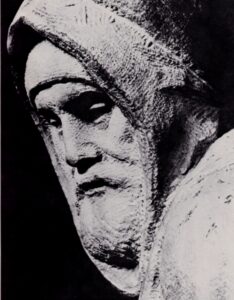
Toward the end of his life, Michelangelo (1475-1564) attempted to sculpt a marble representation of the Pietà – the moment when Christ’s lifeless body is taken from the cross and held by his mother. In this endeavour he was returning to the subject of the sculpture that first brought him fame – the Rome Pietà of 1499. The ageing sculptor was unable to complete his task. One of his efforts – the Florentine Pietà of – he broke into pieces in 1555. A second attempt – the Rondanini Pietà – was still unfinished when he died in 1564. Both sculptures have an intense emotional power.
The Deposition
The gospels provide only a few details about what happened between the death of Jesus on the cross and his entombment. Joseph of Arimathea requested permission from Pilate to bury the body. After the body was taken from the cross, Nicodemus helped to anoint the body with spices in preparation for burial. The body was then placed in an empty tomb, which was sealed with a great stone before the dawn of the Sabbath.
As the centuries passed, believers filled in what must have happened in those hours. Christian iconography describes four episodes. The body is taken down from the cross: the Deposition. Then Mother Mary, the disciples, and various angels weep over the body: the Lamentation. After this period of general grief, Mary alone holds her dead son in her arms: the Pietà. The body is then anointed and placed in the Tomb: the Entombment.
The following is a description of the Deposition from an anonymous 14th-Century Meditations on the Life of Christ, popular in Italy in Michelangelo’s time:
Two ladders are placed on opposite sides of the cross. Joseph ascends the ladder placed on the right side and tries to extract the nail from His hand. But this is difficult, because the long, heavy nail is fixed firmly into the wood; and it does not seem possible to do it without great pressure on the hand of the Lord. Yet it is not brutal, because he acts faithfully; and the Lord accepts everything. The nail pulled out. John makes a sign to Joseph to extend the said nail to him, that the Lady might not see it. Afterwards Nicodemus extracts the other nail from the left hand and similarly gives it to John. Nicodemus descends and comes to the nail in the feet. Joseph supported the body of the Lord: happy indeed is this Joseph, who deserves thus to embrace the body of the Lord! Then the Lady reverently receives the hanging right hand and places it against her cheek, gazes upon it and kisses it with heavy tears and sorrowful sighs. The nail in the feet pulled out, Joseph descends part way, and all receive the body of the Lord and place it on the ground. The Lady supports the head and shoulders in her lap, the Magdalen the feet at which she had formerly found so much grace. (translation Ragusa & Green, 1961).
In the 1520s (or perhaps later), Michelangelo made a drawing of The Deposition that is now in the Teyler Museum in Haarlem (Nagel, 1995). A small gesso relief now in the Victoria and Albert Museum was likely derived from the drawing by one of Michelangelo’s students or apprentices (Chapman, 2005):
The Florentine Pietà
After completing The Last Judgment in the Sistine Chapel in 1541, and the frescos of The Crucifixion of Peter and The Conversion of Paul in the Pauline Chapel in 1549, Michelangelo wished to return to sculpture, and he soon began work on what later became known as The Florentine Pietà. At this time Michelangelo was 75 years old. Sculpting was demanding work even for a young man. Nevertheless, he had become fascinated by the Greek statue of Laocoön and his Sons that had been unearthed in Rome in 1506. This work, likely sculpted in the 1st-Century CE, portrayed three interacting figures. Michelangelo wished to see whether he could carve four interacting figures in the round, and whether he could surpass the ancients by using only one block of marble for this. According to Vasari (1568/1965):
The spirit and genius of Michelangelo could not remain idle; and so, since he was unable to paint, he set to work on a piece of marble, intending to carve four figures in the round and larger than life-size (including a dead Christ) to amuse and occupy himself and also, as he used to say himself, because using the hammer kept his body healthy. This Christ, taken down from the cross, is supported by Our Lady, by Nicodemus (planted firmly on his feet as he bends down and assists and by one of the Marys who also gives her help on perceiving the failing strength of his mother, whose grief makes the burden intolerable. Nowhere else can one see a dead form compare with this figure of Christ; he is shown sinking down with his limbs hanging limp and he lies in an attitude altogether different not only from that of any other of Michelangelo’s figures but from that of any other figure ever made. This work, the fruit of intense labour, was a rare achievement a single stone and truly inspired; but, as will be told later on, it remained unfinished and suffered many misfortunes, although Michelangelo had intended it to go at the foot of the altar where he hoped to place his own tomb.
The illustration below shows the sculpture as viewed from the front and from the right. It probably represents the lowering of Christ’s body from the cross: a Deposition rather than a true Pietà (Fehl, 2002). However, as Finn and Hartt (1975) point out, the Italian word pietà, with its double meaning of “pity” and “piety,” accurately conveys the emotional power of the work.
Christ’s lifeless body is gently lowered from the cross by Nicodemus. Tuscan legends describe Nicodemus as the sculptor who had originally carved the Volto Santo (Sacred Face) in the Cathedral of Lucca, bought there from the Holy Land in the 8th Century CE. Vasari pointed out that the face of Nicodemus in Michelangelo’s sculpture was a self-portrait. The following illustration compares it to a 1545 portrait of Michelangelo, and to a 1560 bust, both by Daniele de Volterra:
Michelangelo worked on the sculpture for several years, but could not make it conform to what he envisioned. The first problem was with Christ’s right leg, which was meant to rest on the lap of the Virgin Mary. The leg did not sit right. Exasperated, he broke the leg off. A later wax model of the sculpture (below, right) shows where the leg would have been. Other problems with the sculpture were that the face of the Virgin Mary was too close to the edge of the marble block to finish properly, and that the figure of Mary Magdalen had to be made smaller than desired. Finally, in 1555, a frustrated Michelangelo broke off the both arms of Christ and the left arm of Mother Mary. The pieces (except for Christ’s leg which has never been found) are shown in the illustration below (left) from a virtual model of the sculpture (Bernardini et al., 2002; Wasserman et al., 2003):
Michelangelo gave the damaged sculpture to his servant Urbino, who sold the pieces to the banker Francesco Bandini. Bandini arranged for Tiberio Calcagni to put the sculpture back together as best he could. Calcagni finished the face of the Magdalen, but not the other figures, which remain as Michelangelo left them. The Florentine Pietà is currently in the Museum of the Cathedral of Florence.
Although maimed, the sculpture still has a tremendous emotional power. This resides mainly in the beautifully sculpted body of the Christ, and in the interaction between the heads of Nicodemus, Christ and the Virgin Mary (the latter from Garoglio et al, 2018):
The Rondini Pietà
A little while after giving away his failed Pietà, Michelangelo started to create another sculpture on the same theme. Some preparatory sketches, now in the Ashmolean Museum in Oxford, are illustrated on the right (Murray, 1980). Michelangelo restricted the new sculpture to just two figures: the Virgin Mary and Christ. The two figures seem to be floating upward toward heaven rather than grounded in the world. The arrangement not realistic: Mary could not support the lifeless body of her son in this manner. The sculpture seems rather to represent the yearning for union between mother and son, a lifelong concern of Michelangelo, who had lost his mother when he was 6 years old.
Initially, the head and torso of Christ would likely have been similar to that of The Florentine Pietà, as suggested by Veres (2019) in the illustration on the right. Michelangelo may have thought the body of Christ too heavy, or perhaps the marble was flawed. Whatever the reason, he erased much of the original body and separated it from its beautifully carved right arm. The head of Christ was removed and recarved in the shoulder of the Virgin.
Irving Stone (1961) imagines:
He rose, picked up his heaviest hammer and chisel and removed the head of Christ, carving a new face and head from what had been the Virgin’s shoulder. He then dissected Christ’s right arm from the body, just above the elbow, though the detached arm and hand remained as part of the supporting marble that went down to the base. What had previously been the left shoulder and part of the chest of Christ he converted into the left arm and hand of the Virgin. Christ’s magnificent long legs were now out of proportion, constituting three fifths of the entire body. The new attenuation created an emotional effect of limpidity, youth and grace. Now he began to be satisfied. Through the distortion of the elongated figure he felt that he had achieved a truth about man: the heart might tire but humanity, carried on its ever-young legs, would continue t move across the face of the earth.
Michelangelo kept the isolated arm, probably as a model for recarving the arm more posteriorly. Two parallel arms can be seen when viewing the sculpture from the left. Michelangelo worked on the sculpture right up to his death, but it remained unfinished:
Barricelli (1993) describes the final form of the sculpture:
Two disquieting figures, not without fear, groping their way out of stone, suggesting in Christ’s upright yet falling pose that death is not a final solution; his feet set outward, in no way sustaining his legs which pull with them a body that clings to the rock as to its sole security. He can neither stand nor fall, breathe nor expire; he shrinks away from his previous vital arm and shows legs that do not seem to belong to his chest, and above these limbs he presents a distorted, unformed face. Here anguish makes no sound, and, except for her eyes, Mary is mute. Her eyes, though, relate a long and painful story; her arm and hand are not poised in an act of giving.
After Michelangelo’s death, his final Pietà somehow wound up in the Palazzo Rondanini in Rome, and has since then been known as The Rondanini Pietà. It is presently housed in the Sforza Castle in Milan.
The Poetry
At the height of his fame, Michelangelo believed that he could accurately depict the human body in marble. Time might later distort the representation, but, even then, one would still be able to see what he had perceived. The following is an unfinished sonnet from 1545:
Molto diletta al gusto intero e sano
l’opra della prim’arte, che n’assembra
i volti e gli atti, e con più vive membra,
di cera o terra o pietra un corp’ umano.
Se po’ ’l tempo ingiurioso, aspro e villano5
la rompe o storce o del tutto dismembra,
la beltà che prim’era si rimembra,
e serba a miglior loco il piacer vano.
To one whose taste is healthy and unspoiled, the work of the first art brings great delight: in wax or clay or stone it makes a likeness for us of the face, the gestures, the whole human body, and indeed gives greater life to the body’s members.
If destructive, harsh and boorish time then breaks, distorts or dismembers such a work, the beauty which first existed is remembered, and keeps for a better place the pleasure that here proved vain. (# 237, translation, Ryan, 1996)
A few years later, Michelangelo became more aware of his limitations. No longer was he able to represent in marble what he had envisioned. The following is one of his last poems:
Giunto è già ‘l corso della vita mia
Con tempestoso mar per fragil barca
Al comun porto, ov’ a render si varca
Giusta ragion d’ogni opra trista e pia:
Onde l’affettuosa fantasia,
Che l’arte si fece idolo e monarca,
Conosco ben quant’ era d’error carca;
Ch’ errore è ciò che l’uom quaggiù desia.
I pensier miei, già de’ mie’ danni lieti,
Che fian or, s’ a due morti m’avvicino?
L’una m’ è certa, e l’altra mi minaccia;
Nè pinger nè scolpir fia più che queti
L’anima volta a quell’ amor divino,
Ch’ aperse a prender noi in croce le braccia.
My life’s journey has finally arrived, after a stormy sea, in a fragile boat, at the common port, through which all must pass to render an account and explanation of their every act, evil and devout.
So I now fully recognize how my fond imagination which made art for me an idol and a tyrant was laden with error, as is that which all men desire to their own harm.
What will now become of my former thoughts of love, empty yet happy, if I am now approaching a double death? Of one I am quite certain, and the other threatens me.
Neither painting nor sculpting can any longer quieten my soul, turned now to that divine love which on the cross, to embrace us, opened wide its arms. (# 285, translation, Ryan, 1996)
(The “double death” is of the body and of the soul. The body must grow old and die; the soul is destined for annihilation without the grace of God.)
Non Finito
During his lifetime, Michelangelo left several works in an unfinished (non finito) state: most importantly, the four Slaves/Prisoners originally sculpted for the tomb of Pope Julius II, and currently in the Accademia Museum in Florence. Many have suggested that Michelangelo deliberately left these incomplete to represent the “eternal struggle of human beings to free themselves from their material trappings” (Accademia website).
However, Michelangelo certainly did not choose to leave his two last Pietàs unfinished. He deliberately broke the Florentine Pietà into pieces. He was still working on the Rondanini Pietà a few days before he died (Bull, 1995). Nevertheless, to the modern eye the defects of these last Pietàs add to their beauty. The viewer imagines what the artist sought to portray, but because of physical limitations or the passage of time, was unable to complete.
One of Michelangelo’s early sonnets considers the role of the sculptor in releasing an ideal form from unformed matter. He realizes that this activity is directed by some force greater than the artist, who is only a transient intermediary in the process of creation:
Se ’l mie rozzo martello i duri sassi
forma d’uman aspetto or questo or quello,
dal ministro che ’l guida, iscorge e tiello,
prendendo il moto, va con gli altrui passi.
Ma quel divin che in cielo alberga e stassi,5
altri, e sé più, col propio andar fa bello;
e se nessun martel senza martello
si può far, da quel vivo ogni altro fassi.
E perché ’l colpo è di valor più pieno
quant’alza più se stesso alla fucina,10
sopra ’l mie questo al ciel n’è gito a volo.
Onde a me non finito verrà meno,
s’or non gli dà la fabbrica divina
aiuto a farlo, c’al mondo era solo.
If my rough hammer, in shaping the hard stones into the form of this or that human appearance, derives its motion from the master who guides, directs and sustains it, then it moves as another would have it do.
But that divine hammer, which lodges and abides in heaven, with its own movement makes others beautiful, and all the more itself; and if no hammer can be made without a hammer, then every other hammer is made from that living one.
And since every blow is of greater strength the higher the hammer is raised at the forge, this one has flown to heaven above mine.
So mine will remain unfinished for me, if the divine smith will not now give help to make it to him who was on earth my only help. (# 46, translation, Ryan, 1996)
Hibbard (1978) considered the unfinished Rondanini Pietà as an indication of Michelangelo’s failing abilities:
But this final statue is the result of old-age debility, and although it is strangely moving, its interest is chiefly autobiographical. Unlike Michelangelo’s other unfinished works, this is hardly a potential work of art. It is a record of the old man’s solitary need to express something more in stone, his beloved enemy. … The Gothic, formless, anti-physicality of this wreck is unbearably pathetic.
Wallace (2009) presents a far more romantic notion of Michelangelo’s last unfinished work:
Michelangelo has carved a miracle, transforming stone first into flesh and then into spirit. Sculpture, the most physical of the arts, is made to express the ineffable.
Barricelli (1993) suggests that The Rondanini Pietà could never have been completed. It depicts the human need to transcend mortality. And we can never know whether or how such a need will be fulfilled.
In The Florentine Pietà the sculptor himself supports the mother and son. In the final Rondanini Pietà, the artist is no longer necessary. The sculpture has become a Resurrection rather than a Deposition. Mary and Jesus rise heavenward by the grace of God. And even if we might now believe in neither God nor Christ, the sculpture still conveys to us the need for human transcendence.
References
Anonymous. (14th Century, translated by Ragusa, I.; & Green, R. B. (1961). Meditations on the life of Christ; an illustrated manuscript of the fourteenth century. Princeton University Press. Available at Internet Archive
Barricelli, J-P. (1993) Michelangelo’s Finito: In the self, the later sonnets, and the last Pietà. New Literary History, 24(3), 597-616.
Bernardini, F., Rushmeier, H., Martin, I.M., Mittleman, J., & Taubin, G. (2002). Building a digital model of Michelangelo’s Florentine Pieta. IEEE computer graphics and applications, 22 (1), 59-67
Bull, G. (1995). Michelangelo: a biography. Viking.
Chapman, H. (2005). Michelangelo drawings: Closer to the master. Yale University Press.
Fehl, P. (2002). Michelangelo’s Tomb in Rome: Observations on the “Pietà” in Florence and the “Rondanini Pietà. Artibus et Historiae. 23, 9-27.
Finn, D., & Hartt. F. (1975). Michelangelo’s three pietàs. H. N. Abrams
Garoglio, A., Salsi, C., & Verdon, T. (2018). Uno sguardo su Michelangelo: le ultime Pietà fotografate da Angelo Garoglio. Skira.
Hibbard. H. (1978). Michelangelo: painter, sculptor, architect. Vendome (Viking).
Michelangelo Buonarroti (1564, translated by Ryan, C., 1996). The poems. J.M. Dent.
Murray, L. (1980). Michelangelo. Oxford University Press.
Nagel, A. (1996) Observations on Michelangelo’s Late Pietà Drawings and Sculptures. Zeitschrift für Kunstgeschichte, 59(4), 548-572.
Stone, I. (1961). The agony and the ecstasy: a novel of Michelangelo. Doubleday.
Vasari, G. (1568, translated by Bull, G. 1965). Lives of the artists. Penguin Books
Veres, P. (2019). Some thoughts on Michelangelo’s last sculpture: the Rondanini Pietà. In Making Art: A Memoir. The First Twenty-Five Years. Regent Press. Available on website
Wallace, W. (2009). Michelangelo: the complete sculpture, painting, and architecture. Universe Press (Rizzoli).
Wasserman, J., Camiz, F. T., Verdon, T., Rockwell, P., & Amendola, A. (2003). Michelangelo’s Florence Pietà. Princeton University Press.



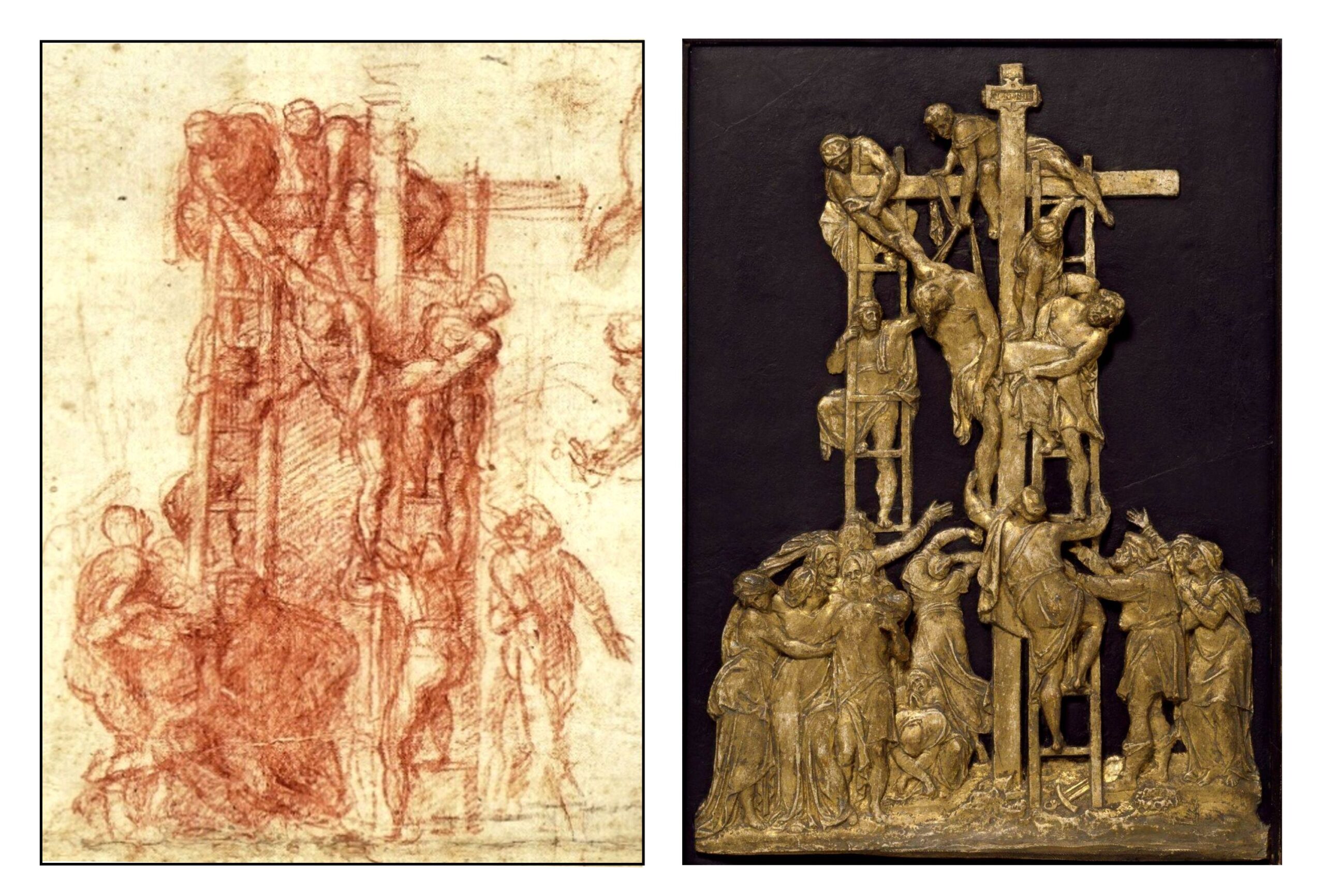
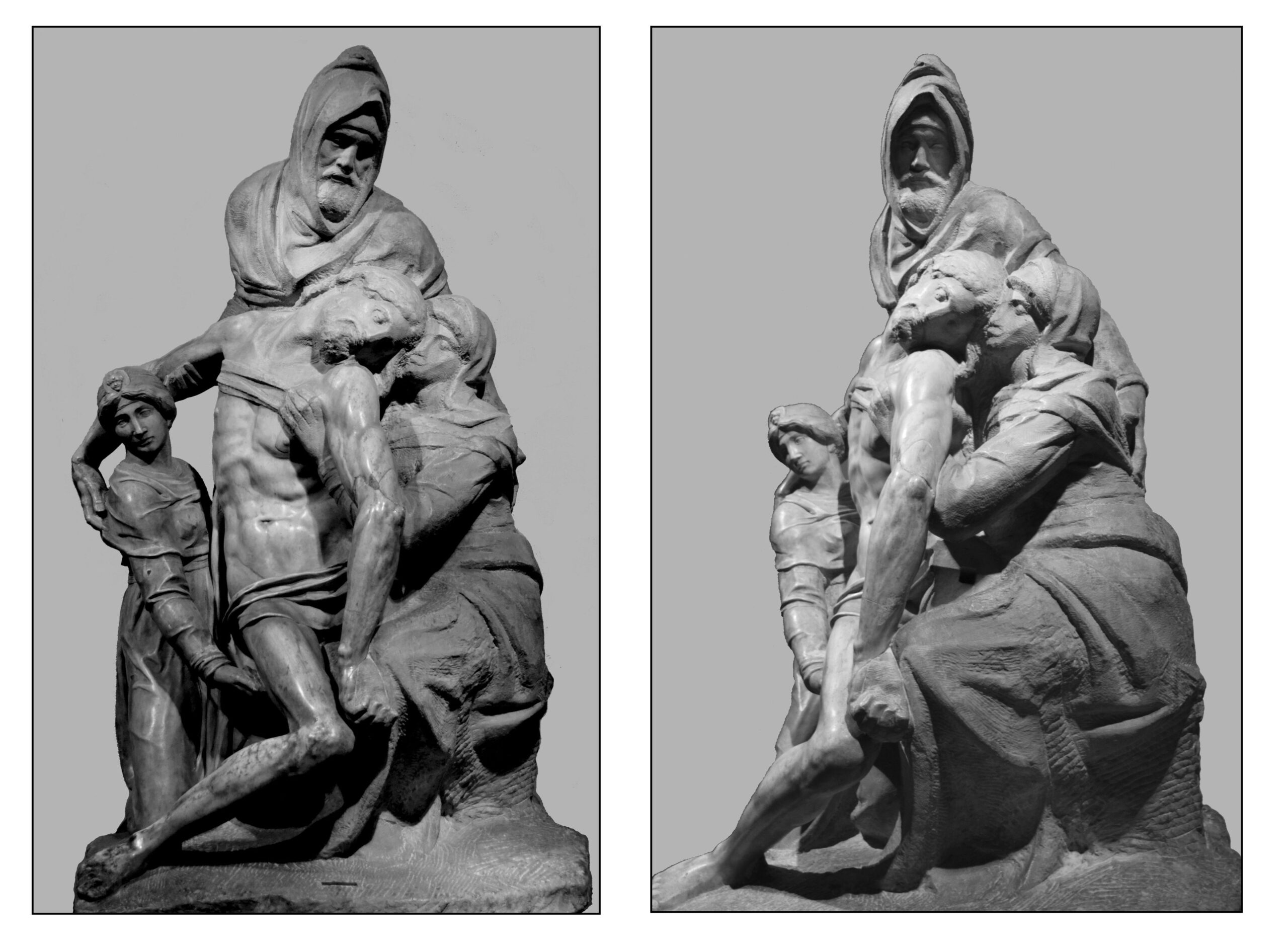



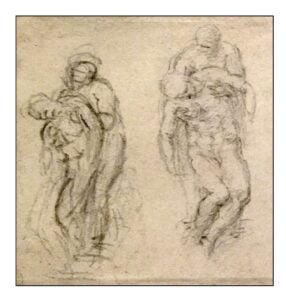
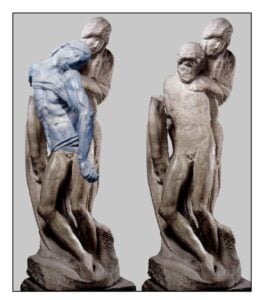

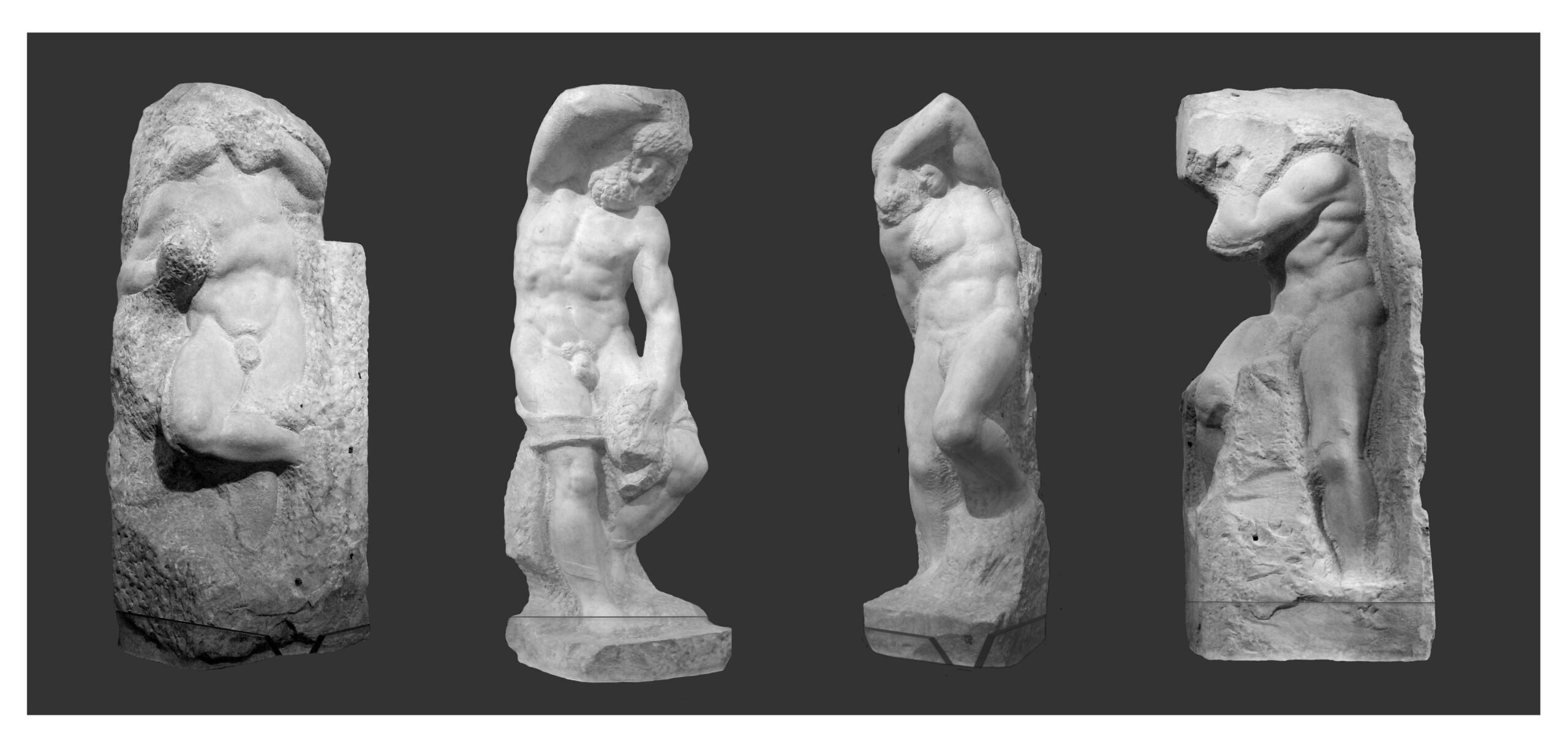
Dear Dr. Picton:
You have written such a beautiful discovery in your piece on Michelangelo.
When he said:
“So I now fully recognize how my fond imagination which made art for me an idol and a tyrant was laden with error,…”
And he said:
“What will now become of my former thoughts of love, empty yet happy, if I am now approaching a double death? Of one I am quite certain, and the other threatens me”.
I believe Michelangelo’s double death is telling. In my review of his poetry, I believe he feels the death in his human body as certain but the double death – the other death – as being the death in his mind “that threatens me…” to not peform perfection in his sculpture of the body of Christ and Mary, in marble and this, is the tyrant in his mind.
I believe he was an intolerable perfectionist to himself, that nothing satisfied his mind when he saw his art of Christ’s death sculpted. And so he would break off pieces to his Pieta(s). His own piety must have been immense and his feelings of worthiness to sculpt the death of Christ, must have been a deep, personal, feeling of offense to God.
I also feel Michelangelo could never believe himself as capable as he himself said his hammer was driven by the heavens. I understand through his poetry that he could not feel connected to his own abilities to reproduce the perfections of Christ’s life on earth. He must have given up at the end of his life to strive for the perfect reproduction in his art – never reachable in himself.
The fact that he never finished his sculpture, I feel was indicative of his final resolution, that art was incapable to reflect the reality of such an intensely intimate moment in the life of Christ on earth. What do you feel?
Thanks for the opportunity to respond.
Best wishes,
Elizabeth Bartoli
I agree that Michelangelo was a perfectionist. In his youth he was able to come close to his ideal in such works as the Vatican Pietà, David, and Moses. As he grew older, he often found himself unable to complete what he set out to sculpt. And perhaps he found his final subject – the death of Christ –particularly difficult as he himself was nearing death. To our modern sensibility, the very incompleteness of the last works powerfully portrays the limits of our understanding.
Death and disability: concepts not difficult to understand if one has experienced such of the latter. But to Michelangelo a tyrany to his “fond imagination which made art for me” …and is “laden with error”, is a difficulty many persons with disabilities face each day in many ways. Certainly, his immortality, at least for five centuries, is in his works.